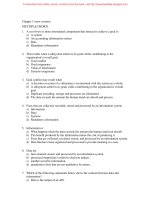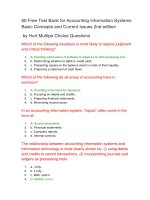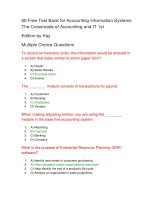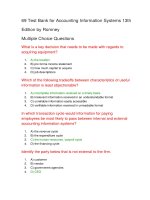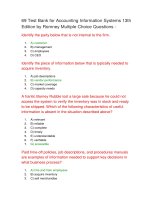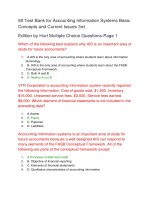40 test bank for intermediate accounting IFRS edition 2nd edition
Bạn đang xem bản rút gọn của tài liệu. Xem và tải ngay bản đầy đủ của tài liệu tại đây (58.59 KB, 12 trang )
40 Test Bank for Intermediate Accounting IFRS Edition
2nd Edition
by Kieso
Multiple Choice Questions
Users of financial reports include all of the following except:
1.
a.creditors.
2.
b.government agencies.
3.
c.unions.
4.
d.All of these are users.
Which of the following statements is true regarding the
International Accounting Standards Board (IASB)?
1.
a.The IASB is a regulatory agency with enforcement powers for its
International Financial Reporting Standards (IFRS).
2.
b.The IASB is a public organization, funded by taxpayer dollars from
member countries.
3.
c.Is compromised of 16 members.
4.
d.All of the choices are correct regarding the IASB.
The financial statements most frequently provided include all of
the following except the
1.
a.statement of financial position.
2.
b.income statement.
3.
c.statement of cash flows.
4.
d.statement of retained earnings.
Which of the following statements is not an objective of financial
reporting?
1.
a.Provide information that is useful in investment and credit decisions.
2.
b.Provide information about enterprise resources, claims to those
resources, and changes to them.
3.
c.Provide information on the liquidation value of an enterprise.
4.
d.Provide information that is useful in assessing cash flow prospects.
What is a possible danger if politics plays too big a role in
developing IFRS?
1.
a.Financial reporting standards that are issued that are not truly generally
accepted.
2.
b.Individuals may influence the standards.
3.
c.User groups become active.
4.
d.The IASB delegates its authority to elected officials.
What would be an advantage of having all countries adopt and
follow the same accounting standards?
1.
a.Consistency.
2.
b.Comparability.
3.
c.Lower preparation costs.
4.
d.Comparability and lower preparation costs
One element of the objective of financial reporting is to provide
1.
a.information about the investors in the business entity.
2.
b.information about the liquidation values of the resources held by the
enterprise.
3.
c.information that is useful in assessing cash flow prospects.
4.
d.information that will attract new investors.
All the following are differences between financial and managerial
accounting in how accounting information is used except to
1.
a.plan and control company's operations.
2.
b.decide whether to invest in the company.
3.
c.evaluate borrowing capacity to determine the extent of a loan to grant.
4.
d.All of these answers are differences.
What is "expectation gap"?
1.
a.The difference between what the public thinks the accountant is not doing
and what the accountant knows they don't do.
2.
b.The difference between what the public thinks the accountant should do
and what Congress says the accountant should do.
3.
c.The difference between what the public thinks the accountant should do
and what the accountant thinks they can do.
4.
d.The difference between what the accountant should do and what the
Courts say the accountant should be doing.
International financial reporting interpretations (issued by the
International Accounting Standards Board)
1.
a.Are considered authoritative and must be followed.
2.
b.Cover newly identified financial reporting issues not specifically
addressed by the IASB.
3.
c.Cover issues where unsatisfactory or conflicting interpretations have
developed.
4.
d.All of the choices are correct regarding International financial reporting
interpretations.
What is the major objective of financial reporting?
1.
a.Provide information that is useful to management in making decisions.
2.
b.Provide information that clearly portray nonfinancial transactions.
3.
c.Provide information that is useful to present and potential equity
investors, lenders, and other creditors in making decisions..
4.
d.Provide information that excludes claims to the resources.
An effective capital allocation process
1.
a.promotes productivity.
2.
b.encourages innovation.
3.
c.provides an efficient market for buying and selling securities.
4.
d.All of these answers are correct.
In the past, many countries have relied on their own standardsetting organizations. The standards issued by these various
standard-setting organizations around the world include
1.
a.Tax-oriented standards.
2.
b.Business-based standards.
3.
c.Principles-based standards.
4.
d.All of these answers are correct.
Which of the following has the highest authoritative support?
1.
a.International Financial Reporting Standards.
2.
b.International Accounting Standards.
3.
c.Interpretations of the IFRIC.
4.
d.Framework for Financial Reporting.
When comparing U.S. GAAP and International Financial
Reporting Standards (IFRS)
1.
a.IFRS are considered more comprehensive than U.S. GAAP.
2.
b.IFRS contain more implementation guidance than U.S. GAAP.
3.
c.IFRS are considered more principles-based than U.S. GAAP.
4.
d.All of the choices are correct regarding U.S. GAAP and IFRS.
Which of the following is an ethical concern of accountants?
1.
a.Earnings manipulation.
2.
b.Conservative accounting.
3.
c.Industry practices.
4.
d.None of the above.
General-purpose financial statements are the product of
1.
a.financial accounting.
2.
b.managerial accounting.
3.
c.both financial and managerial accounting.
4.
d.neither financial nor managerial accounting.
Which of the following is not one of the major types of
pronouncements issued by the International Accounting
Standards Board (IASB)?
1.
a.International financial reporting standard.
2.
b.Memorandum of understanding.
3.
c.Framework for financial reporting.
4.
d.International financial reporting interpretations.
The two major standard-setting organizations in the world are
1.
a.Financial Accounting Standards Board (FASB) and the International
Organization of Securities Commission (IOSCO).
2.
b.Financial Accounting Standards Board (FASB) and the International
Accounting Standards Board (IASB).
3.
c.The International Accounting Standards Board (IASB) and International
Organization of Securities Commission (IOSCO).
4.
d.The International Accounting Standards Board (IASB) and the Standards
Advisory Council (SAC).
The major financial statements include all of the following except:
1.
a.Statement of financial position.
2.
b.Statement of changes in financial position.
3.
c.Statement of comprehensive income.
4.
d.Statement of changes in equity.
Which of these statements regarding the IFRS and U.S. GAAP is
correct?
1.
a.U.S. GAAP is considered to be "principles-based" and more detailed than
IFRS.
2.
b.U.S. GAAP is considered to be "rules-based" and less detailed than
IFRS.
3.
c.IFRS is considered to be "principles-based" and less detailed than U.S.
GAAP
4.
d.Both U.S. GAAP and IFRS are considered to be "rules-based", but U.S.
GAAP tends to be more complex.
As part of the objective of general-purpose financial reporting,
there is an emphasis on “assessing cash flow prospects.” Under
International Financial Reporting Standards (IFRS) this is
interpreted to mean:
1.
a.Cash basis accounting is preferred over accrual based accounting.
2.
b.Information about the financial effects of cash receipts and cash
payments is generally considered the best indicator of a company’s present
and continuing ability to generate favorable cash flows.
3.
c.Over the long run, trends in revenues and expenses are generally more
meaningful than trends in cash receipts and disbursements.
4.
d.All of the choices are correct regarding “assessing cash flow prospects”
under IFRS.
Which of the following organizations is not among the four
international standard-setting organizations?
1.
a.IFRS Foundation.
2.
b.IFRS.
3.
c.IFRS.
4.
d.International Organization of Securities Commissions (IOSCO).
Financial statements in the early 2000s provided information
related to
1.
a.nonfinancial measurements.
2.
b.forward-looking data.
3.
c.hard assets (inventory and plant assets).
4.
d.None of these answers are correct.
Which of the following represents a form of communication
through financial reporting but not through financial statements?
1.
a.Statement of financial position.
2.
b.President's letter.
3.
c.Income statement.
4.
d.Notes to financial statements.
The information provided by financial reporting pertains to
1.
a.individual business enterprises, rather than to industries or an economy
as a whole or to members of society as consumers.
2.
b.business industries, rather than to individual enterprises or an economy
as a whole or to members of society as consumers.
3.
c.individual business enterprises, industries, and an economy as a whole,
rather than to members of society as consumers.
4.
d.an economy as a whole and to members of society as consumers, rather
than to individual enterprises or industries.
Accrual accounting is used because
1.
a.cash flows are considered less important.
2.
b.it provides a better indication of ability to generate cash flows than the
cash basis.
3.
c.it recognizes revenues when cash is received and expenses when cash is
paid.
4.
d. None of these answers are correct.
Which of the following is true with regard to the characteristics of
the International Accounting Standards Board (IASB)?
1.
a.A unanimous vote by all Board members is needed to issue a new
International Financial Reporting Standard (IFRS).
2.
b.The IASB consists of 16 part-time members.
3.
c.Each member of the IASB must come from a different country.
4.
d.IASB members are appointed for 5-year renewable terms.
The process of identifying, measuring, analyzing, and
communicating financial information needed by management to
plan, evaluate, and control an organization’s operations is called
1.
a.financial accounting.
2.
b.managerial accounting.
3.
c.tax accounting.
4.
d.auditing.
What is due process in the context of standard setting at the
IASB?
1.
a.IASB operates in full view of the public.
2.
b.Public hearings are held on proposed accounting standards.
3.
c.Interested parties can make their views known.
4.
d.All of these answers are correct.
The International Accounting Standards Board (IASB) follows
specific steps in developing International Financial Reporting
Standards (IFRS). Place the following steps in the correct order:
1)Research and analysis conducted; preliminary views of pros
and cons issued; 2)Topics identified and placed on the agenda;
3)Board evaluates responses, final standard issued;4)Public
hearing on proposed standard; 5)Board evaluates research,
issues exposure draft.
1.
a.1, 2, 3, 4, 5
2.
b.2, 1, 4, 5, 3
3.
c.1, 2, 5, 4, 3
4.
d.1, 2, 5, 3, 4
Which of the following statements is true?
1.
a.Over 115 countries require or permit use of International Financial
Reporting Standards (IFRS).
2.
b.Canada is the most significant holdout from use of International Financial
Reporting Standards (IFRS).
3.
c.Nearly 50% of investors in the United States own foreign securities, either
directly or through funds.
4.
d.To facilitate efficient capital allocation, investors need relevant information
stated in a common currency.
Which of the following is not a major challenge facing the
accounting profession?
1.
a.Nonfinancial measurements.
2.
b.Timeliness.
3.
c.Accounting for hard assets.
4.
d.Forward-looking information.
The purpose of the International Accounting Standards Board is
to
1.
a.issue enforceable standards which regulate the financial accounting and
reporting of multinational corporations.
2.
b.develop a uniform currency in which the financial transactions of
companies through-out the world would be measured.
3.
c.develop a single set of high-quality IFRS.
4.
d.arbitrate accounting disputes between auditors and international
companies.
The international financial reporting environment includes
challenges in financial reporting including all of the following
except:
1.
a.Political environment.
2.
b.Expectations gap.
3.
c.Decision-usefulness.
4.
d.Ethics.
How does accounting help the capital allocation process attract
investment capital?
1.
a.Provides timely, relevant information.
2.
b.Encourages innovation.
3.
c.Promotes productivity.
4.
d.Provides timely, relevant information and encourages innovation.
Significant financial reporting issues facing global financial
reporting and efficient capital allocation include all of the following
except:
1.
a.How to provide backward-looking information.
2.
b.How to report nonfinancial measures such as customer satisfaction.
3.
c.How to provide forward-looking information.
4.
d.How to provide real-time financial statement information.
The following published documents are part of the "due process"
system used by the IASB in the evolution of a typical IASB
Standard: 1)Exposure Draft; 2)IASB Standard; 3)Discussion
Paper. The chronological order in which these items are released
is as follows:
1.
a.1, 2, 3.
2.
b.1, 3, 2.
3.
c.2, 3, 1.
4.
d.3, 1, 2.
The IASB's standard-setting structure includes all of the following
except:
1.
a.IFRS Interpretations Committee
2.
b.IFRS Advisory Council
3.
c.IFRS Comparison Committee
4.
d.Trustees
Non-financial measurements include all of the following except:
1.
a.backlog information.
2.
b.customer satisfaction indexes.
3.
c.reject rates on goods purchased.
4.
d.All of the choices are non-financial measurements.
